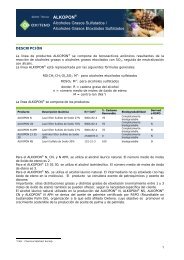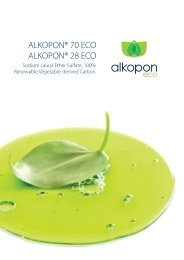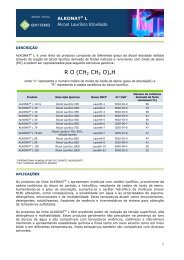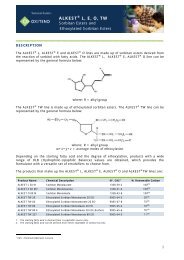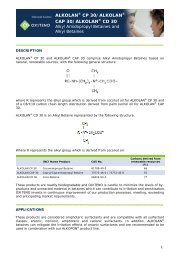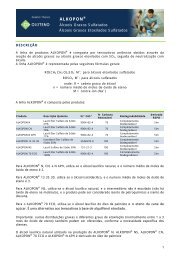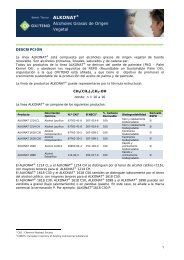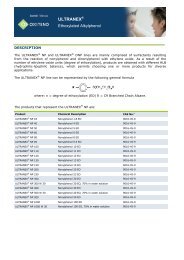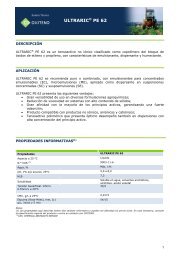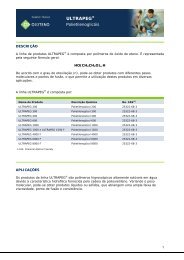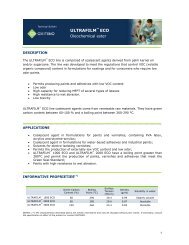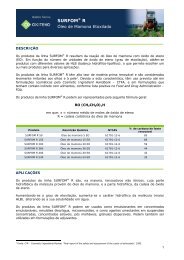GLYCOL ETHERS - Oxiteno
GLYCOL ETHERS - Oxiteno
GLYCOL ETHERS - Oxiteno
Create successful ePaper yourself
Turn your PDF publications into a flip-book with our unique Google optimized e-Paper software.
<strong>GLYCOL</strong> <strong>ETHERS</strong>Glycol EthersDESCRIPTION<strong>GLYCOL</strong> <strong>ETHERS</strong> result from the reaction of alcohols or phenol with ethylene oxide. Thereactions to obtain these compounds and their molecular structures are shown in the figurebelow, starting from methanol and ethanol. The reactions with butanol and phenol are similar.<strong>Oxiteno</strong> produces the following types of glycol ethers: methyl glycol (MEGME), methyl diglycol(DEGME), ethyl glycol (MEGEE), ethyl diglycol (DEGEE), ethyl triglycol (TEGEE), butyl glycol(MEGBE), butyl diglycol (DEGBE), butyl triglycol (TEGBE) and ULTRASOLVE ® P 240 A (phenylglycol or MEGFE).The <strong>GLYCOL</strong> ETHER line is made up of the following products:Product Other denominations CAS 1 numberMETHYL <strong>GLYCOL</strong>METHYL DI<strong>GLYCOL</strong>ETHYL <strong>GLYCOL</strong>ETHYL DI<strong>GLYCOL</strong>ETHYL TRI<strong>GLYCOL</strong>BUTYL <strong>GLYCOL</strong>BUTYL DI<strong>GLYCOL</strong>BUTYL TRI<strong>GLYCOL</strong>Monoethylene glycol methyl ether2-methoxyethanolMEGMEDiethylene glycol methyl etherDEGMEMonoethylene glycol ethyl ether2-ethoxyethanolMEGEEDiethylene glycol ethyl etherDEGEETtriethylene glycol ethyl etherTEGEEMonoethylene glycol butyl ether2-butoxyethanolMEGBEDiethylene glycol butyl etherDEGBETriethylene glycol butyl etherTEGBE109-86-4111-77-3110-80-5111-90-0112-50-5111-76-2112-34-5143-22-6ULTRASOLVE P 240 A Phenyl glycol, Monoethylene glycol phenyl ether, 2-phenoxyethanol, MEGFE 122-99-61. CAS: Chemical Abstracts Service1
<strong>GLYCOL</strong> <strong>ETHERS</strong>Glycol EthersAPPLICATIONSLeathersETHYL DI<strong>GLYCOL</strong>, BUTYL <strong>GLYCOL</strong>, BUTYL DI<strong>GLYCOL</strong> and BUTYL TRI<strong>GLYCOL</strong> are used aspenetrating agents in water-based formulas since they reduce the surface tension of water,increasing penetration of paints and lacquers, and improving resistance and leveling of thefilm.INFORMATIVE PROPERTIES (*)ProductAppearance@ 25°CPt-CoColorDensity20/20°CWater(%wt.)Acidity as AceticAcid (ppm)METHYL <strong>GLYCOL</strong> Clear liquid 10 max. 0.964 - 0.969 0.1 max. 100 max. 124.5METHYL DI<strong>GLYCOL</strong> Clear liquid 10 max. 1.021 - 1.025 0.1 max. 100 max. 194.2ETHYL <strong>GLYCOL</strong> Clear liquid 10 max. 0.930 - 0.933 0.1 max. 50 max. 135.1ETHYL DI<strong>GLYCOL</strong> Clear liquid 10 max. 0.989 - 0.993 0.1 max. 100 max. 202.7ETHYL TRI<strong>GLYCOL</strong> Clear liquid 100 max. 1.020 - 1.060 0.1 max. 100 max. 245.0BUTYL <strong>GLYCOL</strong> Clear liquid 10 max. 0.901 - 0.904 0.1 max. 100 max. 171.2BUTYL DI<strong>GLYCOL</strong> Clear liquid 15 max. 0.954 - 0.958 0.1 max. 100 max. 230.6BUTYL TRI<strong>GLYCOL</strong> Clear liquid 100 max. 0.990 - 0.997 0.1 max. 100 max. 270.0ULTRASOLVE P 240 A Clear liquid 500 max. 1.09 - 1.13 0.3 max. 500 max. 245.0Boiling Pt.(°C)@ 760mm HgNOTE: (*) The properties described above are informative only and may be altered without prior notice. Please consult the productspecification for current details.HANDLING AND STORAGESince these <strong>GLYCOL</strong> <strong>ETHERS</strong> have low vapor pressure, the risks of intoxication from inhalingtheir vapors are small. However, one should avoid prolonged or frequent exposures to theirvapors.During handling, the use of gloves, PVC coat and safety goggles are recommended. Forpotential prolonged exposure, it is advisable to use masks suitable for organic vapors. In caseof accidental contact, act as follows, seeking urgent medical care:• Eyes: wash immediately with abundant water for at least 15 minutes• Skin: remove the contaminated clothing and wash affected parts with abundant water• Ingestion: seek urgent medical care, keeping the head lower than the torso to preventinhaling the product through the lungsContaminated clothes and shoes must be removed and washed before reuse.<strong>GLYCOL</strong> <strong>ETHERS</strong> are classified as flammable or combustible substances, depending on theether type and according to its flash point. It is therefore necessary to protect them fromsources of ignition, such as open flames, hot surfaces, electric discharges, etc. Theextinguishing agents are water, dry chemical powder, carbon dioxide and foam.Because <strong>GLYCOL</strong> <strong>ETHERS</strong> are hygroscopic, we recommend storing under an inert atmosphere,preferably nitrogen, to minimize water absorption.2
<strong>GLYCOL</strong> <strong>ETHERS</strong>Glycol Ethers<strong>GLYCOL</strong> <strong>ETHERS</strong> should not come in prolonged contact with air due to the possibility offorming peroxides.To store <strong>GLYCOL</strong> <strong>ETHERS</strong>, we recommend using AISI 304 or 316 stainless steel tanks.Aluminum and its alloys should be avoided. Polymeric coatings are not recommended due tothe excellent solvency power of <strong>GLYCOL</strong> <strong>ETHERS</strong>.® <strong>Oxiteno</strong>’s Registered Trademark.DISCLAIMERThis bulletin contains information given in good faith, based on <strong>Oxiteno</strong>’s current knowledgeon the subject, and is purely indicative. Any information, including suggestions for using theproducts, should not preclude experimental testing and verification, which are essential toensure the suitability of the products to each specific application. All users shall also abide bylocal laws and obtain all necessary permits. When handling the product, consult the safetydata sheet. In case of questions or additional needs, please contact <strong>Oxiteno</strong> through ourcustomer service channels.0520123



